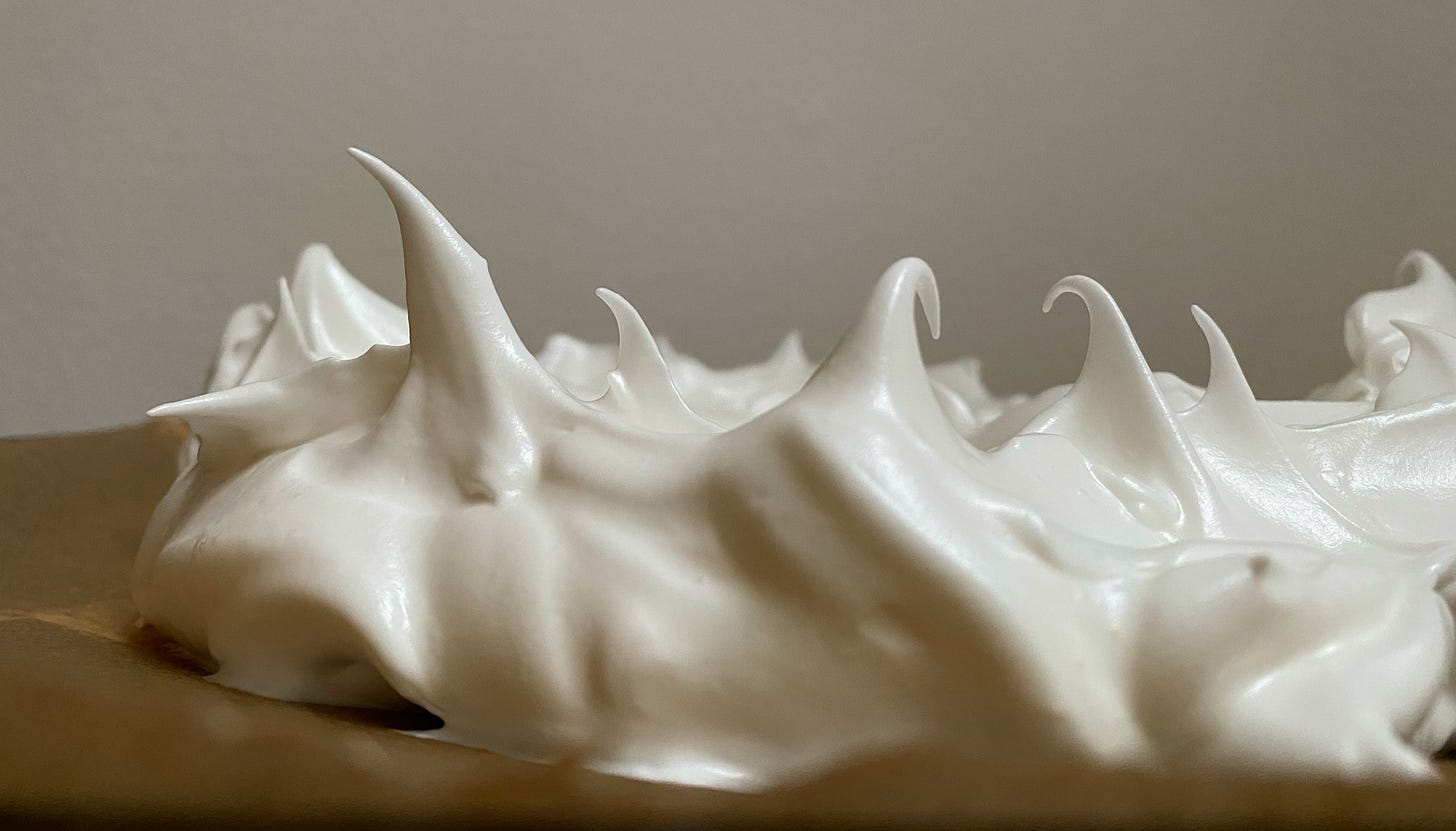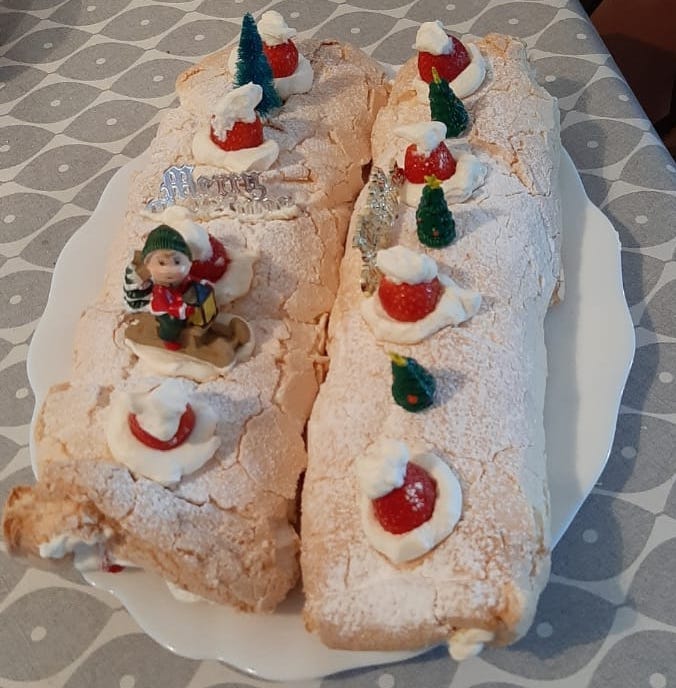It’s still Sunday!!! *she says in defeat at getting this one over the line*. Full disclosure, it didn’t work to perfection; she needed more love and more testing but look at those peaks!!!
I once read a piece that implied food writers and bloggers should just get on with the recipe and stop waffling on about history and who’s grandmother it came from because nobody has the time or inclination for such things. Rude. It stuck with me for a long time, partially because I have an irritating disposition towards people-pleasing but more so because I too regularly find myself searching for ‘recipe only’ inspiration of a week night.
I was inclined to give the recipe first here to keep it short and sweet but I’ve been swayed by the opinion that playing to my own impatience or lack of inclination to scroll to the end for measurements is madness. So… lets give peas a chance. Yeah, I went there.
We’re going with a classic this week and the alternative version takes planning, none of which I did successfully. I also got side tracked for a few days assessing the science of cobwebs around my house and wondering how they managed to appear out of nowhere. Some riveting breakfast conversation with the hubs went something like “did you know that cobwebs lie flat against walls so that you can hardly see them?”. A cocked eyebrow of concern was as expected and I acknowledged that Googling the science of cobwebs in a lockdown fatigue frenzy was not my finest moment but it could be worse.
Mad Pav Love
“… it’s misguided to believe that recipes are invented – rather, recipes evolve over time, often in more than one location…” - Darra Goldstein
Memories are funny old things. Nobody ever remembers things quite as you do, unique in every detail you can recount in every slightly different version that gets told. The roots of pavlova are no different as Australians and New Zealanders seem to both think they invented it and named it after a Russian ballerina, Anna Pavlova who toured both countries in the early 1900s.
Dig a little deeper and you are quickly shot into centuries of meringues with endless years of research, documentaries and books on the matter that I have yet to even scratch the surface of. That I’m excited by this shouldn’t surprise you.
I’m not going to reinvent the meringue wheel here, although Nigella pushed the boat out with her marooki cookies. Oh Nigella, finding new words for just about everything!! Pavlova yanks me right back to my grandmother’s kitchen because it was one of the first bakes I learned to make under the tutelage of my aunt, Pat. Separating egg whites successfully without bits of shell in them was quite the life skill.
Pavlova was and still is one of Pat’s signature desserts. She learned how to make it shortly after she got married in her mid-twenties from a lady who used to bake for the country market in Bandon, West Cork. She showed her once how to make it and the rest as they say is history.
The recipe used has never changed, doesn’t use vinegar or cornflour as traditionalist pavlova makers might and sticks with a classic that doesn’t need to be toyed with to be impressive.
That said, over the years it has morphed into roulade and Eton mess when accidents called for a quick transformation, but no matter what form the meringue takes after baking, it is always worth fighting over to get the last mouthful and there will never be a scrap of it left. Ever.
Aquafaba (chickpea gloop)
Brace yourselves. I don’t eat eggs anymore. *gasp*. But, it never fails to astound me the beauty created with the humble egg and the aquafaba version of this meringue is no different.
The research on aquafaba (chickpea water from the can or jar), although more recent is no more understood. Nobody really knows how or why the slimy liquid from tinned chickpeas works so well as an egg replacer but it does look very like egg white. I’ve only started to scratch the itch of what’s possible here but this meringue is a good start.
Cook’s notes:
To egg or not egg is your prerogative. The same rules apply.
You start with a white gloop that you whisk until fluffy.
You add the sugar slowly, a table spoon at a time.
The same cooking methods applies to both versions.
You let the meringue cool down in the oven for at least an hour or more.
As we can’t share food with as many people right now feel free to half the recipe. Pat’s pavlova would probably feed about 9-12 whereas my aquafaba version will feed 4 approx.
If you’re making the aquafaba version, don’t do what I did and forget to put your can of coconut milk in the fridge overnight, delaying everything. Also, don’t buy Biona’s whipping coconut cream for this… there’s nothing whippable about it and it just didn’t work for me for any number of reasons. More testing needed but lets just spell out d.i.s.a.s.t.e.r and be done with it.
The egg recipe needs no tweaking but I can’t say the same for the aquafaba version. It needs a little somethin’but overall I was impressed with the meringue itself.
Instructions appear twice to save you scrolling back and forth.
Pat’s pavlova
A classic topped with tinned mandarins, chopped fresh kiwi, sprinkled Cadbury’s chocolate flake and cream spread thickly and evenly across the crisp peaked meringue base from edge to edge.
Ingredients for the meringue:
4 egg whites
225g white caster sugar
Pinch of salt
Ingredients for the topping:
300ml of whipping cream
Tablespoon of sugar to sweeten
1 tin of mandarin segments (drained)
1 kiwi (chopped into 2cm pieces)
Crushed Cadbury flake chocolate bar (sprinkled on top)
Instructions:
Pre-heat your oven to 130/140C (fan oven) or gas mark 2
Whisk 4 egg whites until stiff. The aim here is that you have thick fluffy peaks in your egg whites starting to form and once you have, add in the sugar slowly (tablespoon at a time) while whisking.
Put some parchment on a baking tray and you can stick a little whipped egg white to the underside of the parchment to help it stay in place on the tray.
Spoon out the meringue into the middle of the parchment paper into whatever shape you want, ensuring that the outer parts are at least higher than the middle part that forms your base. A circle is the easiest option here so imagine a paddling pool shape… flatter on the base then it is higher on the sides.
Bake at 130/140C for an hour and then turn off your oven and let it cool in there for at least an hour.
Once cool, whip up your cream, smooth on top of the meringue and top with your fruit of choice, in this case drained tinned mandarins, kiwi and flakes of chocolate.
Peaslova
(sorry, couldn’t resist)
Ingredients for the meringue:
Half the liquid from a drained tin of chickpeas
85g caster sugar
½ teaspoon cream of tartar
Ingredients for the topping:
250ml of full fat coconut milk
½ tin of mandarin segments (drained)
½ kiwi (chopped into 2cm pieces)
Grated dark chocolate (sprinkled on top)
Instructions:
Pre-heat your oven to 130/140C (fan oven) or gas mark 2
Whisk the aquafaba until it starts to foam and thicken. You cannot, repeat cannot over whip aquafaba so keep going until you think the consistency is thick enough before adding sugar.
Add in the sugar slowly (tablespoon at a time) while whisking. If you’re using an electric hand blender you will start to feel the consistency of the whites thicken as you whisk. What you’re looking for is a fluffy glossy thick white mix that holds a peak.
Put some parchment on a baking tray and you can stick a little whipped ‘white stuff’ to the underside of the parchment to help it stay in place on the tray.
Spoon out the meringue mix into the middle of the parchment paper into whatever shape you want, ensuring that the outer parts are at least higher than the middle part that forms your base. A circle is the easiest option here so imagine a paddling pool shape… flatter on the base then it is higher on the sides.
Bake at 130/140C for an 1 - 1½ hours and then turn off your oven and let it cool in there for at least an hour.
Once cool, whip up your coconut cream, smooth on top of the meringue and top with your fruit of choice, in this case drained tinned mandarins, kiwi and flakes of chocolate.
Want more?
If that tickled your fancy, each Sunday a little edition of the Bia letter goes directly to your email if you subscribe but if your inbox is a heaving hot mess like some of mine and you could do without one more email, you can find everything in the archive.
In the meantime, tell people you think might like a food story and see you next Sunday 14th Feb for Valentines/Galentines/Palentines Day!
Say hi!
Find me on Instagram as @biaasundayfoodletter and @eattosurvivehumansandearth.
If you like a hashtag or cook a thing lets meet up here - #biaasundayfoodletter










